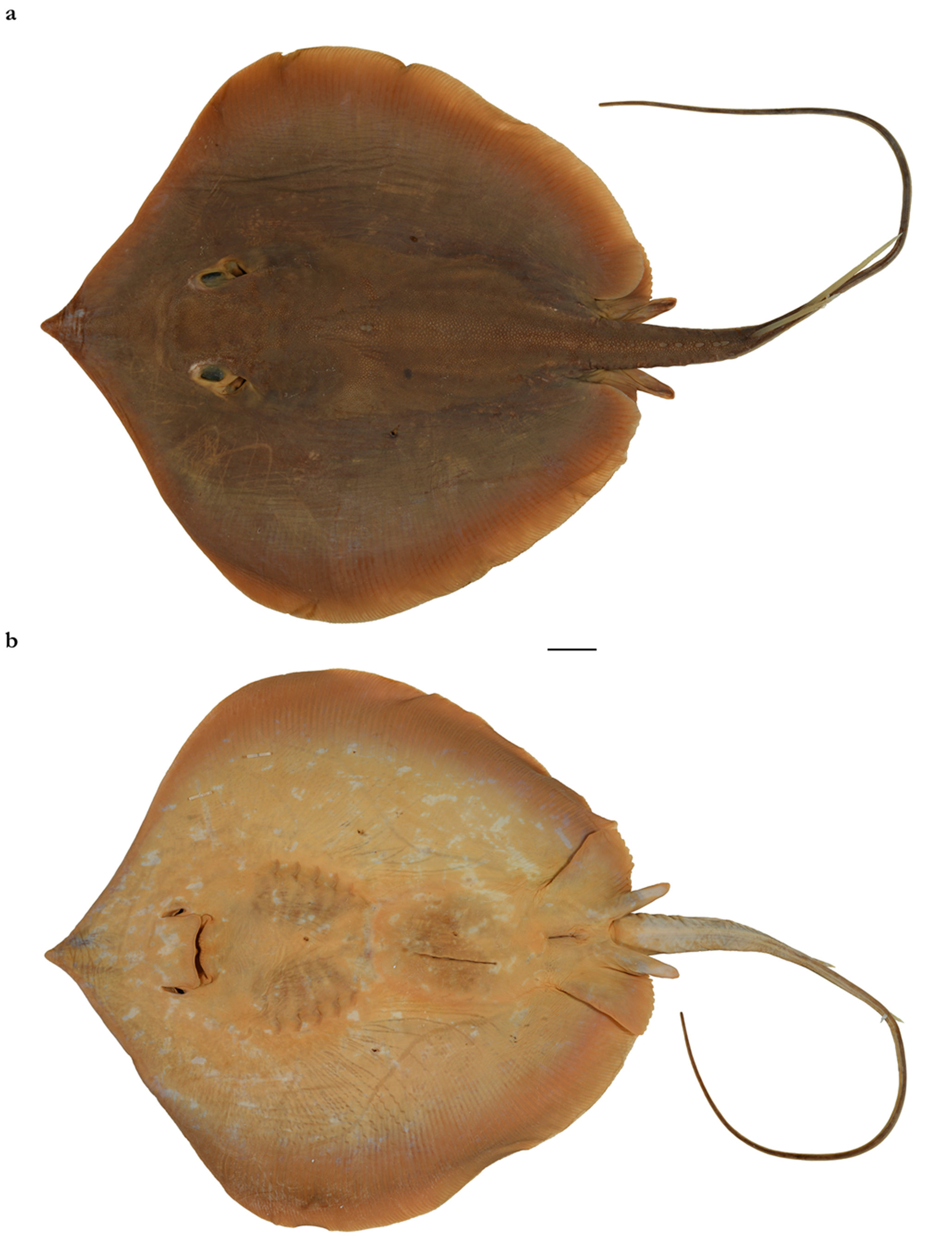Brevitrygon manjajiae
Last, Weigmann & Naylor, 2023
Classification: Elasmobranchii Myliobatiformes Dasyatidae
Reference of the original description
The Indo-Pacific Stingray Genus Brevitrygon (Myliobatiformes: Dasyatidae): Clarification of Historical Names and Description of a New Species, B. manjajiae sp. nov., from the Western Indian Ocean. Diversity, 15(12), Article 1213
The Indo-Pacific Stingray Genus Brevitrygon (Myliobatiformes: Dasyatidae): Clarification of Historical Names and Description of a New Species, B. manjajiae sp. nov., from the Western Indian Ocean. Diversity, 15(12), Article 1213
Types
Brevitrygon manjajiae
Holotype: USNM: 222555; Paratype: CSIRO: H 7627-02; CSIRO: H 7627-03; LACM: 38129-83(1); LACM: 38129-83(2); LACM: 38129-83(3); LACM: 38130-60(1); LACM: 38130-60(2); LACM: 38130-60(3); LACM: 38130-60(4); LACM: 38133-56(2 of 15); LACM: 38314-24; LACM: 38134-37; MNHN: 7924; USNM: 470881(2); USNM: 222585; USNM: 222624(1); USNM: 222624(2); USNM: 222624(3); USNM: 222624(4); ZMH: 1385; ZMH: 4465;
Brevitrygon manjajiae
Holotype: USNM: 222555; Paratype: CSIRO: H 7627-02; CSIRO: H 7627-03; LACM: 38129-83(1); LACM: 38129-83(2); LACM: 38129-83(3); LACM: 38130-60(1); LACM: 38130-60(2); LACM: 38130-60(3); LACM: 38130-60(4); LACM: 38133-56(2 of 15); LACM: 38314-24; LACM: 38134-37; MNHN: 7924; USNM: 470881(2); USNM: 222585; USNM: 222624(1); USNM: 222624(2); USNM: 222624(3); USNM: 222624(4); ZMH: 1385; ZMH: 4465;
Description :
Citation: Brevitrygon manjajiae Last, Weigmann & Naylor, 2023: In: Database of modern sharks, rays and chimaeras, www.shark-references.com, World Wide Web electronic publication, Version 04/2024
Please send your images of "Brevitrygon manjajiae" to info@shark-references.com

Brevitrygon manjajiae Last, Weigmann & Naylor, 2023; holotype, USNM 222555, adult male 231 mm DW, off Miani Hor, Pakistan, Arabian Sea, collected RV Anton Bruun, 8 December 1963 © Last, Weigmann & Naylor, 2023

Brevitrygon manjajiae Last, Weigmann & Naylor, 2023; holotype, USNM 222555, adult male 231 mm DW, off Miani Hor, Pakistan, Arabian Sea, collected RV Anton Bruun, 8 December 1963 © Last, Weigmann & Naylor, 2023
Common names
 Sandwich-tail Whipray
Sandwich-tail Whipray
 Sandwich-tail Whipray
Sandwich-tail Whipray
Short Description
Original diagnosis of Last, Weigmann & Naylor, 2023 [32458]: (based on Arabian Sea material). A Brevitrygon (to at least 25 cm DW) distinguished by the following combination of features: snout length 28–30% DW, angle 108–113°; disc longer than wide; orbits small, diameter 5–6% DW; nostrils 4–5% DW and internasal width 11–13% DW; tail relatively short, longer in males (1.3–1.5 times DW) than females (0.9–1.3 times DW), with rudimentary, ridge-like ventral fold and fleshy lateral ridges (Figure 34); pelvic fins relatively small, length 17–19% DW; postcloacal length of clasper to 19% DW; 1–5 (usually 1) small, seed- or heart-shaped scapular denticles, no scute-like thorns on dorsal surface of disc; secondary denticle band well developed and sharply demarcated in adults, not strongly constricted over branchial region, width across scapulocoracoid and over abdomen subequal, then converging posteriorly near pectoral-fin insertions; tail with well-developed denticle band forward of sting, with 3–8 enlarged seed to weakly lanceolate denticles or small thorns (typically 2.5–5 mm long); dorsal surface mainly uniformly brownish when skin undamaged, disc margin slightly paler brown; ventral disc, pelvic fins, and tail white, margins of pectoral and pelvic fins dark; pectoral-fin radials 102–111; total vertebral count (excluding first synarcual centra) 87–101.
Original diagnosis of Last, Weigmann & Naylor, 2023 [32458]: (based on Arabian Sea material). A Brevitrygon (to at least 25 cm DW) distinguished by the following combination of features: snout length 28–30% DW, angle 108–113°; disc longer than wide; orbits small, diameter 5–6% DW; nostrils 4–5% DW and internasal width 11–13% DW; tail relatively short, longer in males (1.3–1.5 times DW) than females (0.9–1.3 times DW), with rudimentary, ridge-like ventral fold and fleshy lateral ridges (Figure 34); pelvic fins relatively small, length 17–19% DW; postcloacal length of clasper to 19% DW; 1–5 (usually 1) small, seed- or heart-shaped scapular denticles, no scute-like thorns on dorsal surface of disc; secondary denticle band well developed and sharply demarcated in adults, not strongly constricted over branchial region, width across scapulocoracoid and over abdomen subequal, then converging posteriorly near pectoral-fin insertions; tail with well-developed denticle band forward of sting, with 3–8 enlarged seed to weakly lanceolate denticles or small thorns (typically 2.5–5 mm long); dorsal surface mainly uniformly brownish when skin undamaged, disc margin slightly paler brown; ventral disc, pelvic fins, and tail white, margins of pectoral and pelvic fins dark; pectoral-fin radials 102–111; total vertebral count (excluding first synarcual centra) 87–101.
Distribution
off Miani Hor (Pakistan) to Mumbai (western India), but further range extensions east and west are likely with targeted collecting. [32458]
off Miani Hor (Pakistan) to Mumbai (western India), but further range extensions east and west are likely with targeted collecting. [32458]
Size / Weight / Age
TL (max): males to 246 mm DW (550 mm TL), females to 228 mm DW (439 mm TL) [32458]
TL (max): males to 246 mm DW (550 mm TL), females to 228 mm DW (439 mm TL) [32458]
Dentition
Teeth of adult male (CSIRO H 7627-03) slightly larger in upper jaw than in lower jaw; upper jaw teeth in rows, broadly suboval with short cusps, largest near symphysis and on lateral knobs; lower jaw teeth in quincunx, suboval, more strongly cuspid near symphysis (Figure 36a–c); immature male (LACM 38314-24, 246 mm DW) with similar-sized, quincuncial teeth in both jaws, cusps weak. In slightly smaller female (LACM 38134-37, 207 mm DW), teeth more broadly oval, in strong quincunx, acuspid (Figure 36d–f). Tooth rows in CSIRO H 7627-03 and LACM 38129-83, 1 of 3, ~33–46 in upper jaw, ~42–56 in lower jaw, ontogenetic differences in counts likely. [32458]
Teeth of adult male (CSIRO H 7627-03) slightly larger in upper jaw than in lower jaw; upper jaw teeth in rows, broadly suboval with short cusps, largest near symphysis and on lateral knobs; lower jaw teeth in quincunx, suboval, more strongly cuspid near symphysis (Figure 36a–c); immature male (LACM 38314-24, 246 mm DW) with similar-sized, quincuncial teeth in both jaws, cusps weak. In slightly smaller female (LACM 38134-37, 207 mm DW), teeth more broadly oval, in strong quincunx, acuspid (Figure 36d–f). Tooth rows in CSIRO H 7627-03 and LACM 38129-83, 1 of 3, ~33–46 in upper jaw, ~42–56 in lower jaw, ontogenetic differences in counts likely. [32458]
Remarks
shark-references Species-ID=16586
shark-references Species-ID=16586
















